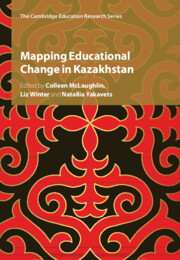Book contents
- Mapping Educational Change in Kazakhstan
- Mapping Educational Change in Kazakhstan
- Copyright page
- Dedication
- Contents
- Figures
- Tables
- Contributors
- Preface
- Acknowledgements
- Introduction
- Part I Foundations of Scaling Up
- Part II Piloting Initiatives and Scaling Up to the Whole System
- 6 Piloting the Renewed Content of Education
- 7 Revising the Content and Standards of Student Assessment
- 8 New Ways of Financing Schools
- 9 Professional Capacity of the Leading Schools as a Managing Mechanism in Updating the Content of Secondary Education in Kazakhstan
- 10 The Teacher Leadership in Kazakhstan Initiative
- 11 Developing Teachers as Researchers
- Part III Evidence of Implementation
- Conclusions
- Select Bibliography: School-Level Educational Reforms in Kazakhstan, 2011–2022
- Index
- References
6 - Piloting the Renewed Content of Education
from Part II - Piloting Initiatives and Scaling Up to the Whole System
Published online by Cambridge University Press: 09 November 2023
- Mapping Educational Change in Kazakhstan
- Mapping Educational Change in Kazakhstan
- Copyright page
- Dedication
- Contents
- Figures
- Tables
- Contributors
- Preface
- Acknowledgements
- Introduction
- Part I Foundations of Scaling Up
- Part II Piloting Initiatives and Scaling Up to the Whole System
- 6 Piloting the Renewed Content of Education
- 7 Revising the Content and Standards of Student Assessment
- 8 New Ways of Financing Schools
- 9 Professional Capacity of the Leading Schools as a Managing Mechanism in Updating the Content of Secondary Education in Kazakhstan
- 10 The Teacher Leadership in Kazakhstan Initiative
- 11 Developing Teachers as Researchers
- Part III Evidence of Implementation
- Conclusions
- Select Bibliography: School-Level Educational Reforms in Kazakhstan, 2011–2022
- Index
- References
Summary
Schools had started piloting the Renewed Content of Education with Grade 1 in September 2015, then moved on to Grade 2 in 2016 and to Grade 3 in September 2017. The pilot schools acted as test sites one year ahead of the full roll-out to all mainstream schools in Kazakhstan. The research evidence collected over the two-year period comprises a mixed sample of primary grade (Grades 1–4) teachers, comparing those starting their second or third year of teaching the new content with those who were yet to have direct experience of it. Interviews and/or focus groups with teachers, school principals and vice-principals were conducted in each of six schools. In addition, primary grade teachers were invited to respond to surveys. The areas of inquiry included overall opinions as well as more targeted attitudes towards the revised content of the curriculum, changes to teaching and learning, new approaches to assessment and the support afforded to implement the new curriculum. The chapter will show that piloting had been a very worthwhile step in the implementation of a new curriculum, with a growing confidence and appreciation of what this curriculum aimed to achieve.
- Type
- Chapter
- Information
- Mapping Educational Change in Kazakhstan , pp. 95 - 112Publisher: Cambridge University PressPrint publication year: 2023



